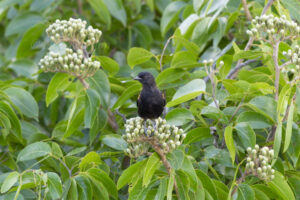 The morning is still fresh and I want to visit the light gallery forest within the Fazenda in the morning. Again a great sunrise. I start walking with my Nikon Nikkor AF-I 300mm f/2.8 D ED on a Gitzo Monopod and a Metz flash MZ-5. Right at the beginning, there is light forest with its cactus undergrowth. And within a beautiful black bird with distinguished brown epaulets greets me. It is an Epaulet Oriole I can photograph briefly.
The morning is still fresh and I want to visit the light gallery forest within the Fazenda in the morning. Again a great sunrise. I start walking with my Nikon Nikkor AF-I 300mm f/2.8 D ED on a Gitzo Monopod and a Metz flash MZ-5. Right at the beginning, there is light forest with its cactus undergrowth. And within a beautiful black bird with distinguished brown epaulets greets me. It is an Epaulet Oriole I can photograph briefly.
It turns out in 2022 that the bird is now no longer called so, but Variable Oriole. The name Variable Oriole is new for many birders, because until recently the individuals in the Pantanal belonged to the Epaulet Oriole complex, i.e. to Icterus cayanensis. Now the detached species has even been given a new scientific name: Icterus pyrrhopterus. Essentially, the darker colored versions south of the Amazon basin were separated from the yellow colored species in the north. The taxonomy of this oriole is complex, but in some areas of Bolivia yellow-shouldered (epaulet) and chestnut-shouldered (variable) orioles are found in the same areas, with no evidence of hybridization. There really should be no clearer test of species status than this. Variable Oriole is a species of forests, open woodlands, secondary forest, parks and gardens. Unlike the more northerly Epaulet Oriole, it has no particular preference for palms, especially the Moriche palm. It occurs from sea level to elevations of at least 1500 m. The widespread southern form of This oriole, pyrrhopterus, is all black with a chestnut-colored epaulet. It is a small, thin, and long-tailed species. Further north in Bolivia and western Brazil, the epaulet is slightly lighter, brownish in color. In south-central Brazil, the epaulets turn yellowish brown, while in eastern Brazil, the oriole has even more yellowish epaulets and yellow legs. The species seen/photographed clearly had chestnut colored shoulders.
Specifically, in the northern Pantanal, it is probably the subspecies Icterus pyrrhopterus periporphyrus, closely associated with the nominate species, which occurs in northeastern Bolivia and the adjacent western Brazil, i.e., central Mato Grosso.
In my birdlist Icterus pyrrhopterus does not appear yet. So it remains with the “old” taxonomy.
A good starting point to get to know the bird world of the northern Pantanal is the Fazenda Tereza. It is located directly on the shore of the bird-rich Rio Pixaim. The 3 kilometer long and very bumpy turnoff to the lodge is at kilometer 63 on the Transpantaneira, just behind the Mato Grosso Hotel. This accommodation is still signposted as Fazenda Tereza. Recently, however, it is called Southwild Pantanal Lodge.
To cope with the growing demand for top shots of the rarer species of the Palearctic Bird-Lens is keen to enrich the range of pictures of birds you can find in the western palearctic and beyond. Trips to remote places like this one to capture images not only of rare birds of western palearctic were very successful. The nice image of the blog is only a first impression, what you will find in the gallery in the “Picture Shop” very soon. Just give bird-lens.com a message, if bird-lens.com could serve you with an image needed before the new pictures are online.